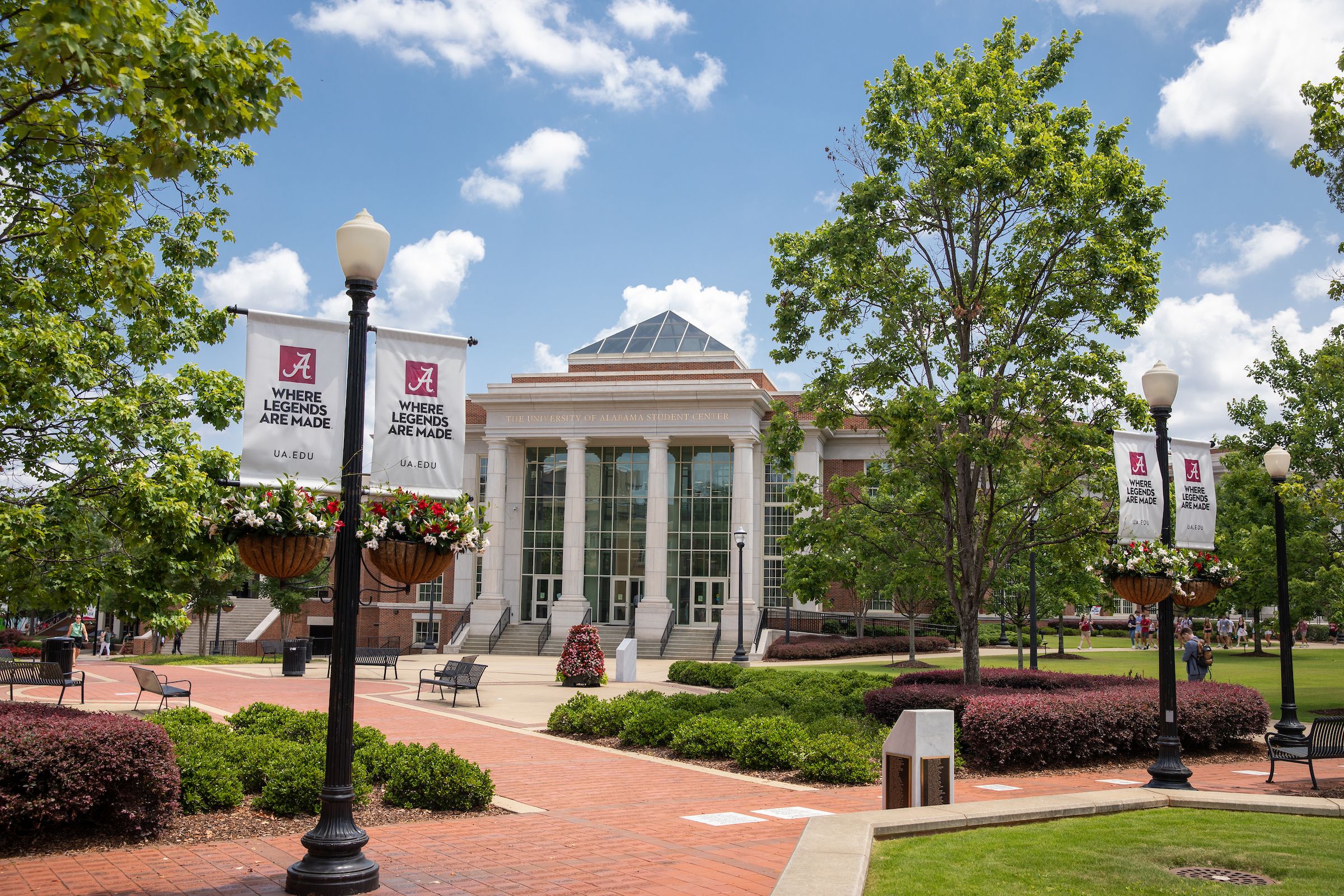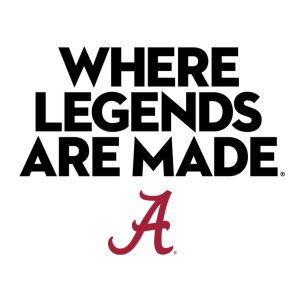Contents
SUMMARY
The University of Alabama, established in 1831 in Tuscaloosa, is the flagship institution of the University of Alabama System and one of the oldest public universities in the United States. Known for its academic excellence, research contributions, and cultural impact, it serves more than 38,000 students annually. The university offers undergraduate, postgraduate, and doctoral programmes across sciences, engineering, business, arts, and humanities, and has built a strong reputation in athletics.
HISTORY
The University of Alabama was founded by the Alabama Legislature in 1820 and officially opened its doors to students in 1831, making it the state’s first public university. It was built on land in Tuscaloosa when the city was still Alabama’s capital, reflecting the state’s vision to provide higher education for future leaders. In its earliest years, the university offered a traditional classical curriculum, with emphasis on Greek, Latin, philosophy, and mathematics. By the mid-19th century, it had become an influential educational hub in the Southern United States, producing graduates who went on to shape state and national affairs.
During the American Civil War, UA played a unique role as it was transformed into a training school for Confederate officers. In 1865, Union troops set fire to much of the campus, destroying most buildings except a few that stand today, including the President’s Mansion. Following the war, UA struggled to rebuild. The late 19th and early 20th centuries saw gradual expansion, with new academic programmes, construction of key facilities, and efforts to modernise its curriculum to meet the industrial and scientific demands of the era.

A turning point came in the mid-20th century during the civil rights movement. UA became a centre of national attention in 1963 when Governor George Wallace attempted to block African-American students Vivian Malone and James Hood from enrolling. Their successful admission marked a milestone in desegregation and reshaped the university’s legacy. From the late 20th century onwards, the University of Alabama expanded its research capacity, developed professional schools, and broadened its global outreach. Its athletics programme, particularly the Crimson Tide football team, brought national recognition, creating a cultural identity that extended far beyond academics.
Today, the University of Alabama stands as a comprehensive research university, balancing historic traditions with modern innovations. It is classified as an R1: Doctoral University, indicating the highest level of research activity, and continues to be a leading institution in the Southeastern Conference and beyond.
VISION
The founding vision of the University of Alabama was rooted in the belief that higher education should serve as the foundation of progress for a young state and nation. Its creators envisaged an institution that would educate future leaders in philosophy, science, law, and governance, providing a cultivated citizenry capable of guiding society forward. Over the decades, this vision has been adapted but remains consistent in its emphasis on excellence. The university strives to foster intellectual growth, critical thinking, and civic responsibility, ensuring that students are prepared not only for professional success but also for community leadership. The vision also integrates research, innovation, and inclusivity as central themes.
TOP COURSES
While the University of Alabama is traditionally associated with engineering, business, and law, it also offers strong programmes in creative disciplines such as fashion, design, and art. The Department of Clothing, Textiles, and Interior Design provides comprehensive courses in fashion retail, apparel design, and sustainable textile innovation. The University of Alabama’s art and design programmes are rooted in a balance of theory and practice. Students explore visual communication, fine arts, and applied design, supported by access to studios, galleries, and digital resources. The faculty combines academic teaching with professional industry experience, giving students a real-world perspective on creative industries. Graduates from these courses have gone on to careers in fashion houses, design firms, art galleries, and cultural institutions. The programmes also encourage research in areas such as wearable technology, cultural aesthetics, and sustainability in fashion, positioning the university as a competitive player in these fields.
EXECUTIVE BOARD
Dr. Stuart R. Bell – President
Dr. James Dalton – Executive Vice President and Provost
Dr. Matthew Fajack – Vice President for Finance and Operations
Dr. Russell Mumper – Vice President for Research and Economic Development
Dr. G. Christine Taylor – Vice President and Associate Provost for Diversity, Equity and Inclusion
JOB INTEGRATION RATE
The University of Alabama maintains a strong record of graduate employability, with many students securing positions within six months of graduation. Career services, internship opportunities, and industry partnerships play a vital role in helping students transition smoothly into professional environments. Fields such as business, engineering, and computer science consistently report some of the highest job placement rates, reflecting the university’s strong ties with regional and national employers. In addition, creative arts and design students benefit from portfolio development, exhibitions, and career fairs that connect them to recruiters. The job integration rate is further supported by alumni networks spread across the United States and internationally. Employers recognise the University of Alabama brand, not only for academic quality but also for the discipline and leadership skills instilled in students through its diverse academic and extracurricular programmes.
AWARDS AND RECOGNITION
The University of Alabama has been recognised for excellence in research, community engagement, and athletics. It has received accolades for its commitment to sustainability, innovation, and the promotion of diversity in higher education. National rankings regularly place UA among the top public universities in the United States, particularly in law, business, and engineering. Its creative programmes have also earned distinction for their focus on applied learning and industry collaboration. In athletics, the Crimson Tide football team has won multiple national championships, contributing significantly to the university’s prestige. Beyond sport, faculty and student research has gained international recognition, reinforcing UA’s reputation as a comprehensive centre of excellence.
REFERENCES
- “University of Alabama (UA)”. The Encyclopedia of Alabama.
- “2022-2023 Annual Financial Report” (PDF).
- “U.S. and Canadian 2023 NCSE Participating Institutions Listed by Fiscal Year 2023 Endowment Market Value,” (XLSX).
- “College Navigator – The University of Alabama”. nces.ed.gov.
- “Colors – Brand Guidelines”. University of Alabama Division of Strategic Communications.
- “Carnegie Classifications | Institution Lookup”.
- “The Burning of the University of Alabama”. Alabama Heritage. Spring 1990
- The Law of Descent of Thought: Law, History, and Civilization in Antebellum Literary Addresses, Law and Literature “The Militarisation of the University of Alabama”.
- “Julia S. Tutwiler”. Encyclopedia of Alabama.
- “World War II and the Tech Connection”. Georgia Tech Alumni Association.
- “1963 Year in Review – Part 1”. United Press International.
- “Autherine Lucy Foster: The Life of a Legend”. University of Alabama News.
- “In Memoriam – April 27, 2011 Storm”. ua.edu.
- “Degrees Given Posthumously To Ala. Tornado Victims”. NPR.org.
- “Tornado-delayed graduation finally held at Alabama”. News Tribune.
- “University graduates, grieves six lost students”. Reuters.
- “Facility Facts”. University of Alabama Facilities.
- “University Planning, 2012 Campus Master Plan Update”.
- “College Sustainability Report Card 2011”. Sustainable Endowments Institute.
- “On-campus gravesite recalls antebellum university”. ua.edu.
- Frank Moody Music Building (University of Alabama)


